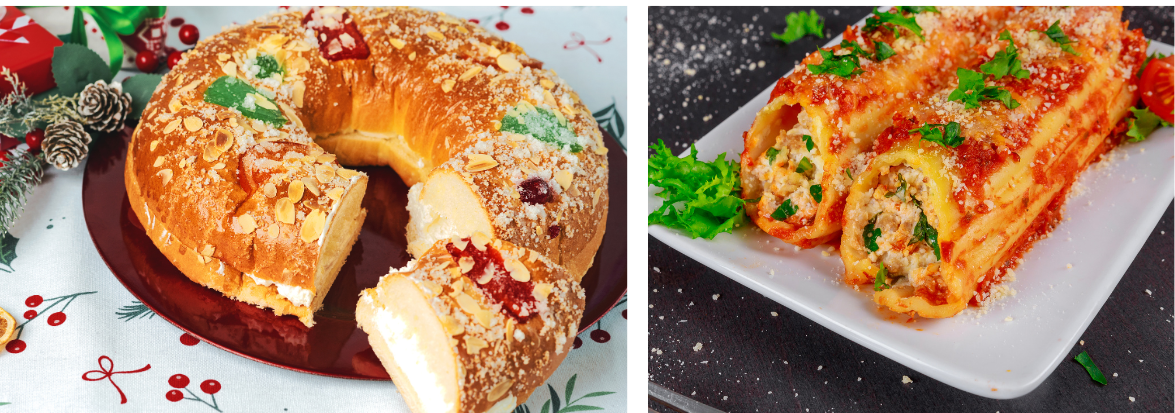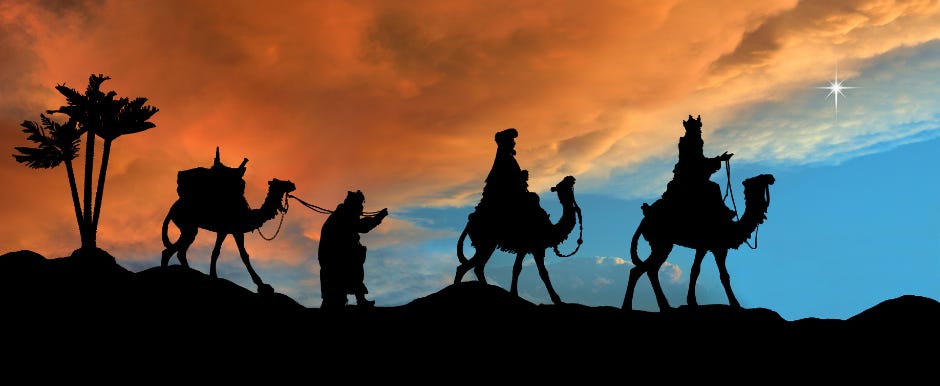Roscóns and Canelons
Two Christmas favourites - a king's crown and a feast for St Stephen.
As I mentioned last week, the 5th and 6th of January are the highlight of the Christmas season for Spanish families, in the same way kids in other countries look forward to Santa making his way down the chimney (or window/airduct, I guess, if you live in a flat) on Christmas Eve.
Early January, when Christmas has wound down for the rest of us and we head back to school and work, Spanish kids are a bundle of nerves with the anticipated arrival of the Three Kings/Wise Men and their camels laden with presents. On the evening of the 5th, Gaspar, Melchor, and Balthasar make their way to every town and city around the country to join in the colourful Cabalgata parade.
According to biblical accounts, the Wise Men brought gold, frankincense, and myrrh to baby Jesus, and have continued the tradition by bringing gifts to children all over Spain. Their parades are spectacularly festive events in which schools and organisations often get involved as well as hundreds of volunteers.
Mechanised floats are decked out in the Court of Melchor, followed by King Melchor himself, then the Court of Gaspar, and King Gaspar himself, and next the Court of Balthasar, and King Balthasar himself. There are marching bands, performers, dancers, and finally, at the end, representatives of the Devil who have prepared lumps of coal for the naughtiest children.
That night before going to bed, each member of the family must leave a shoe out under the Christmas tree, much in the same way we leave stockings out to be filled. This is so the Kings will know how many people there are in the family and their ages. It’s also very important to leave out some milk and cookies for the Kings and hay or carrots and a bowl of water for the camels to help them get through their long night’s work.
The next morning, the kids rush to see what the Wise Men have left them. The 6th of January is a public holiday in Spain, so the day is spent with family at home, opening presents and enjoying a meal together. One of the most popular traditions this day is Spain’s Christmas cake – the Roscón de Reyes (Kings’ Cake) – a ring-shaped cake decorated with almonds and red and green glace fruit.
The cake resembles a wreath or crown, is soft and citrusy, and often filled with cream. Whoever gets the slice with the hidden figurine will have good luck for the year, and those who end up with the dried bean will be expected to buy next year’s Roscón.
The origin of this cake is unclear, but some date it to the 11th century and a festival known as “King of the Bean”. A child from one of the poorest families was crowned King of the Epiphany and was given gifts. Or it may come from the pagan Roman “Saturnalia” that was celebrated every December with cakes made from dried fruits and honey. Hidden inside the cakes were a bean and the ones who found them were made “king of the day”. It may also simply be an edible version of the Advent Wreath.
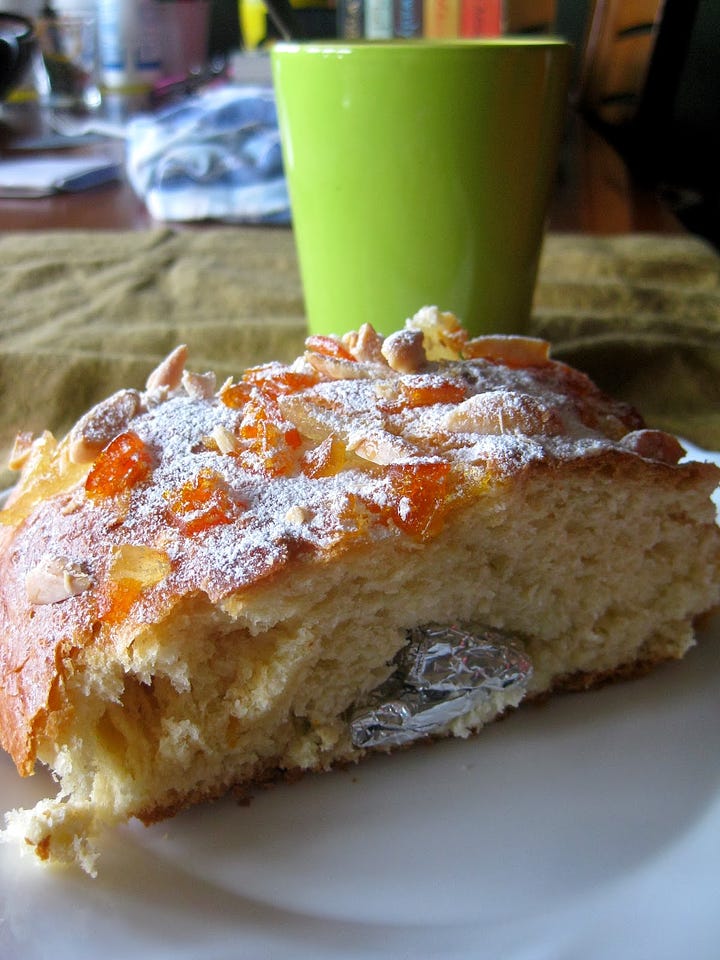
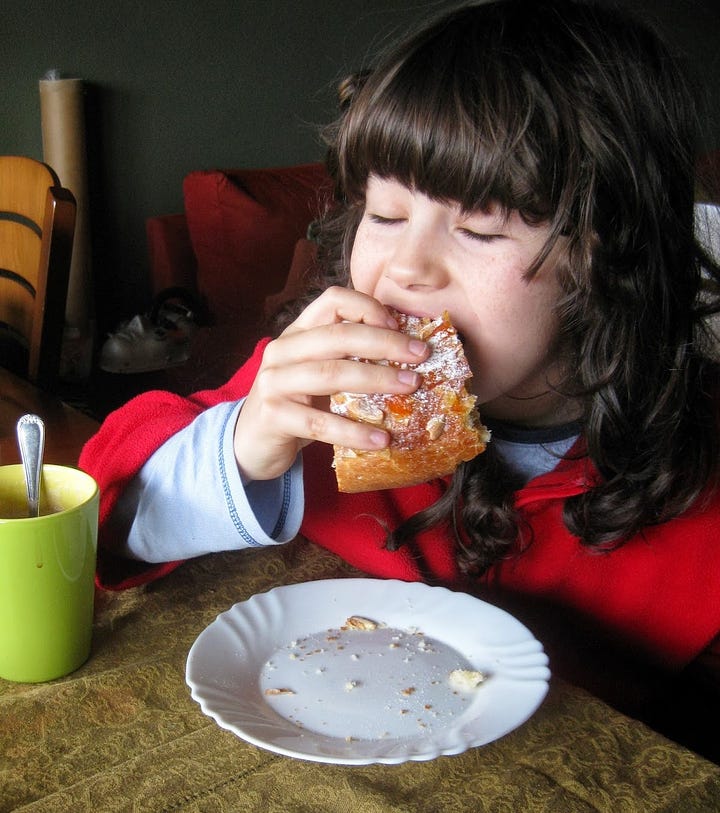
Many years ago when my son was little, we decided to have a go and make a Roscón ourselves. It turned out surprisingly good and though I no longer have the recipe I used, this recipe is probably the closest to what we made. The cake is not overly sweet, and for those who are not able to eat almonds, they are, of course, optional. The glace or dried fruit adds sweetness, colour, and texture to the final result. We made the dough the night before and let it rest during the night. The morning of the Three Kings, we cooked it and ate it warm and soft for breakfast, along with a cup of hot chocolate.
Roscón de Reyes
200ml warm milk
10g dried yeast (half tsp)
600g bread flour
150g sugar
2 eggs
80g unsalted butter at room temperature
Zest of one orange and one lemon
A little orange blossom water or orange brandy (optional)
5g salt
Candied/glace fruit
Almond flakes (optional)
Whipped cream (optional)
Make a well with the flour in a bowl.
Pour in all the ingredients and mix carefully. Use a clean hand to combine the ingredients thoroughly.
Turn out onto a floured board and knead the dough for ten minutes until soft and elastic.
Place back in a lightly greased bowl, cover, and leave for an hour in a warm place until it has doubled in size.
Deflate the dough by pressing it gently.
This is the time to add a clean figurine (not one likely to melt in the oven) and/or bean to the dough. Take care of any small objects that may be accidently swallowed.
Make a ring shape in the dough by pressing in a couple of fingers from the centre and pulling out carefully.
Place the circle on greaseproof paper on the oven tray. Cover with plastic film or a cloth and let it rest again in a warm place at least 40 minutes.
Brush with egg and decorate with candied fruits and almonds (optional).
Bake in a pre-heated 165 C (339 F) oven for 35 minutes until it is golden and makes a hollow sound when tapped on its base.
Let cool a little before enjoying with a cup of hot chocolate.
If you prefer it with whipped cream, let cool entirely before slicing the cake lengthwise and spreading with cream.
Finally, dust with powdered sugar.
This recipe was borrowed from HERE.
Canelons
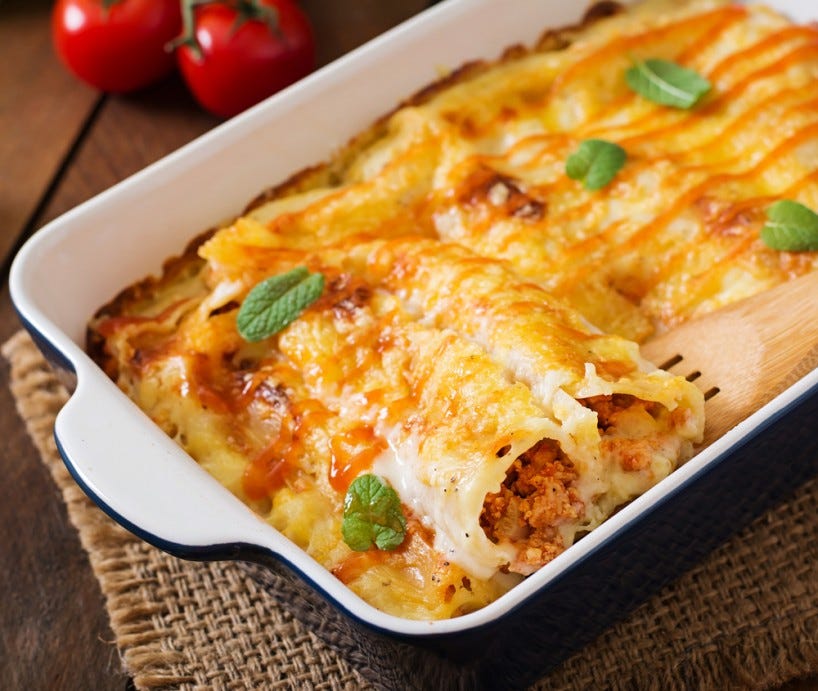
The 26th of December is a regional holiday in Catalunya that celebrates the Feast of St Stephen, known for his appearance in the Christmas Carol ‘Good King Wenceslas’, written by John Mason Neale in 1853.
“Good King Wenceslas looked out, on the feast of Stephen.
When the snow lay round about
Deep and crisp, and even.”
(Apologies if you now have that song stuck in your head all day).
Stephen was a Greek Jew who converted to Christianity and became the first Christian martyr when he was stoned to death in 34 CE. Today he is the patron saint of bricklayers (the stone connection?) and horses.
In Catalunya, they mark his day by creating a lasagne-like dish which uses the leftovers from the Christmas meals. The dish became popular a century ago as a quick easy dish made with the recently imported pre-made cannelloni, and continues to be a favourite mainstay across the region.
If you don’t have left-over meats and vegetables to use as fillers, here’s a recipe you can use instead.
Filling
Two chicken breasts (or turkey) chopped into small pieces.
1 onion
2 cloves of garlic
2 medium tomatoes
1/2 tsp mixed herbs
2 tbsp olive oil
1 tbsp brandy (optional)
1 packet of cannelloni
Bechamel
1 tbsp butter
4 cups milk approx. (or combination milk and cream)
2 tbsp flour
pinch of nutmeg
salt and pepper to taste
grated cheese (eg: cheddar, parmesan…..)
In a frying pan, sauté the onion and garlic in olive oil.
Add the chopped white meat, then the herbs, tomatoes, and a splash of brandy or water/chicken stock.
Simmer gently till the chicken is cooked and the liquid has evaporated. Season to taste.
In a saucepan, melt the butter on a low heat and add the flour.
Stir quickly with a wooden spoon into a smooth paste.
Add a little milk and continue stirring.
Keep adding the milk as the mixture thickens, stirring continuously.
Don’t stop stirring because the mixture will get lumpy.
Continue adding milk/cream little by little until the mixture stops thickening. The consistency of the bechamel should be like that of thick cream when it falls off the spoon.
Take it off the heat, add salt, pepper and a pinch of nutmeg.
Putting it together
Cook the cannelloni pasta (if necessary) according to the instructions on the packet.
Let dry on kitchen paper.
Grease an oven-proof dish.
Take each cannelloni and stuff carefully with the chicken mixture.
Line them up in the dish before pouring the bechamel over the top.
Bechamel can be replaced by a tomato salsa if preferred (see first picture)
Sprinkle with the grated cheese and place in a hot oven till the cheese has turned golden brown.




